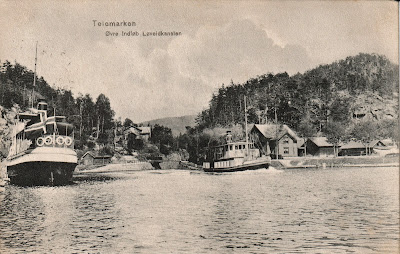Bornholm, Denmark, 1982
Published by Colberg Boghandel a/s Rønne, Denmark this week’s used postcard is an Eneret card #1640 and features a cute illustration from the island of Bornholm showing fishermen, herring, and smokehouses. At the lower right is “Hvor silden går I brede stimer ligger øen med de fleste solskinstimer” that roughly translates to: Where the herring nets are found in wide shoals lies the island with the most hours of sunshine.” The card would probably be termed a novelty card because of the cartoon-like picture.
Unlike most of the rest of Denmark, which is somewhat flat with low rolling hills, Borholm is a rocky island rising high out of the sea. The northern part of the island is very rocky while the southern tip has a beach with some of the most fine grained sand found anywhere. The middle of the island is farmland. In addition to its round churches, the island is also famous for its herring fishing and smokehouses. Two smokehouses can be seen at the upper left on the card. Herring drying are found at the right edge, and the rest of the picture shows the process of fishing, cleaning, preparing the herring, and smoking the fish. Drying racks can be seen just in back of the two women taking fish out of a basket. The catch of the day is found on the docks and by the building in the center of the card. There is even a whimsical black cat who has just finished eating a herring. The artist’s signature is found along the right side “Bjerno.”
Because of its weather and the geology of the island it is known as the “sunshine island.” The heat from the summer is stored in the rock formations and the weather stays warm until October. The southern sandy beaches are popular vacation swimming and camping areas.
I was surprised and delighted to find that my mother had
kept this card we mailed to her while on a trip to Scandinavia in 1982. My youngest son was 4 years old and quite
taken with the picture on the card. He
wanted to send it to his grandma and so he did with some help. The main reason for visiting Bornholm on that trip was to see where my paternal grandfather, Axel Schrøder, was born and lived as a boy. Although we were not able to find his exact home, we found the town, got an idea of where the farm was located and what it was like where he grew up.
Danish stamp, issued 1981
The stamp, issued in 1981, has a picture of N.F.S. Gundtvig’s childhood home. Gundtvig (1783-1872) was a Danish Lutheran pastor, author, poet, philosopher, historian, teacher and politician who was one of the most influential people in Danish history. He and his followers are credited with influencing modern Danish national consciousness. He was a contemporary of Hans Christian Andersen and Søren Kierkegaard; however, his writings are not as well known internationally.
For additional information, see:
https://en.wikipedia.org/wiki/Bornholm
https://visitbornholm.com/en/cities-places/selected-places/smokehouses
https://en.wikipedia.org/N._F._S._Gundtvig






